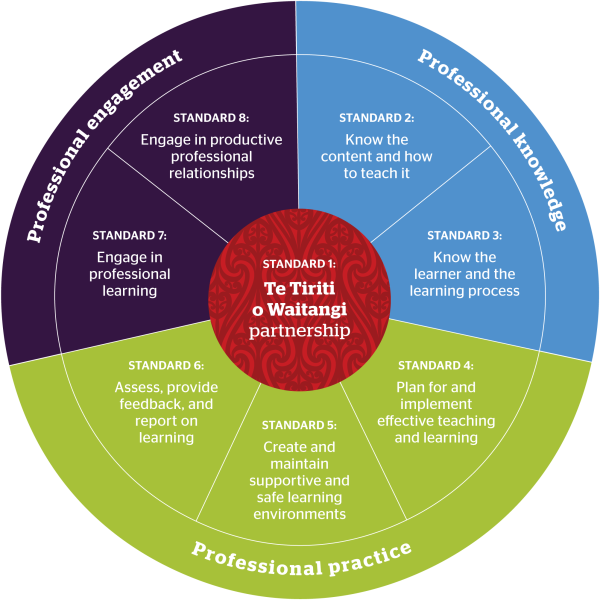Move to new Standards for the Teaching Profession over 2026 and 2027
26 June 2025
How the ‘switch-over’ will work in practice
Early childhood education (ECE) services and schools should expect to be using the 2026 Standards:
- for the Professional Growth Cycle (PGC) from 2026, and
- as the basis for re-certification from 2027.
But we will be developing and sharing further guidance on how to use and interpret the 2026 Standards before that (further detail below). So, principals and ECE professional leaders do not need to feel they have to devise their own approaches unaided.
For 2025, PGC annual summary statements will continue to be based on the 2017 Standards.
When schools and ECE services begin their PGC in 2026, they will need to firstly facilitate a common understanding of the 2026 Standards and what meeting and using them in their practice looks like in their setting (PGC Element A).
When it comes time for PGC Element E to be enacted, i.e. each teacher’s annual summary to be completed, the recognition that a teacher's practice meets the Standards will be according to the Standards used in Element A for that year.
Endorsement decisions for the renewal of practising certificates are made every three years. Principals and professional leaders will use the most recent annual summary statements of the previous three years to endorse teachers for their practising certificates.
This means that for a time, endorsement decisions will be made from annual summary statements that represent practice from both the 2017 and 2026 Standards.
Support for implementation
During the second half of 2025, the Teaching Council will develop and publicise the following:
- A Guide to the 2026 Standards and Focus Areas, which provides some context on the intent of the drafting.
- Transitioning from the 2017 Standards to the 2026: What’s Similar and What’s Different?, which will provide an accessible guide to the points of continuity between the old and new standards, along with slight changes of nuance or emphasis, and those aspects which are more fundamentally new.
- Refreshed written and audiovisual resources on the Elements of the Professional Growth Cycle, which take account of the 2026 Standards (including the new role of the focus areas) and identify how to recognise these standards in teaching practice in a meaningful yet accessible way.
We will commence updating the Endorser Guidelines in 2025, in consultation with interested stakeholders, but the work may continue into 2026.
The 2026 Standards at a glance
The 2026 Standards are intended to build upon the 2017 Standards, preserving many of their key features.
They are made up of eight standards that describe what high-quality teaching practice looks like and what it means to be a teacher in Aotearoa New Zealand.
These eight standards, spread across three domains, are set out in the diagram below.

Each standard contains a set of focus areas that provide additional detail. The focus areas are intended to interpret each standard and support teachers to identify and develop high quality practices in their settings.
The standards and focus areas in full can be found in Introducing the 2026 Standards for the Teaching Profession. They have also been laid out as an A3 table.
Implications for Initial Teacher Education (ITE)
As noted above, the 2026 Standards will come into formal effect from 1 January 2027, including for ITE programmes. The Teaching Council will work with ITE providers to develop a plan to update and approve programme changes that prepare graduates to meet the 2026 Standards (in a supported environment).
The Teaching Council is looking to reduce monitoring and review obligations of existing programmes while updates are made. More information will be available to ITE providers shortly.
We will also work to help providers ‘dovetail’ the impacts of our changes with those of other processes that they need to respond to (in particular curriculum change).
The forthcoming What’s Similar and What’s Different? document (signalled above) will be designed to be a valuable resource for providers in considering to what extent programme content and structure needs to be adapted for the 2026 Standards.
Following the current consultation on the discussion paper A nationally consistent Induction model to support new teachers, revised documentation to support the induction and mentoring process will also be developed. This will also take account of the shift to the 2026 Standards.
Towards new Ngā Paerewa
Leading up to the release of the standards consultation document, we began the process of engagement with leaders of the profession in Māori medium settings to develop a new expression of the standards in te reo Māori, i.e. a successor to the 2017 Ngā Paerewa. However, other challenges facing Māori medium settings mean that it will now not be realistic to complete this work in 2025.
Nevertheless, we consider that it will be feasible for work to be undertaken with Māori medium leaders as well as Māori leaders in English medium settings, to enable these standards to be approved in 2026. This would allow them to come into effect in 2027 alongside the standards as expressed in English.
Current thinking is that the new standards in te reo Māori might be similar to the English standards but not a direct translation.
